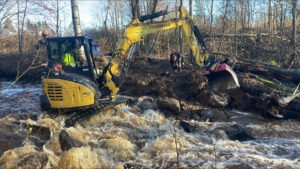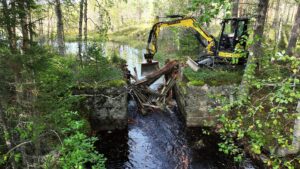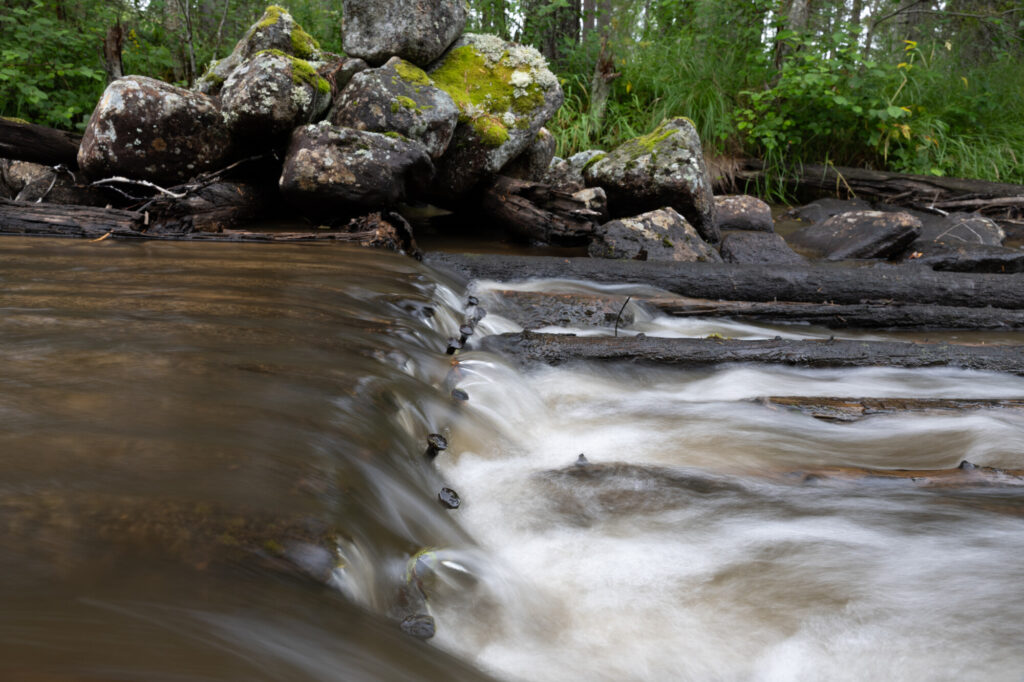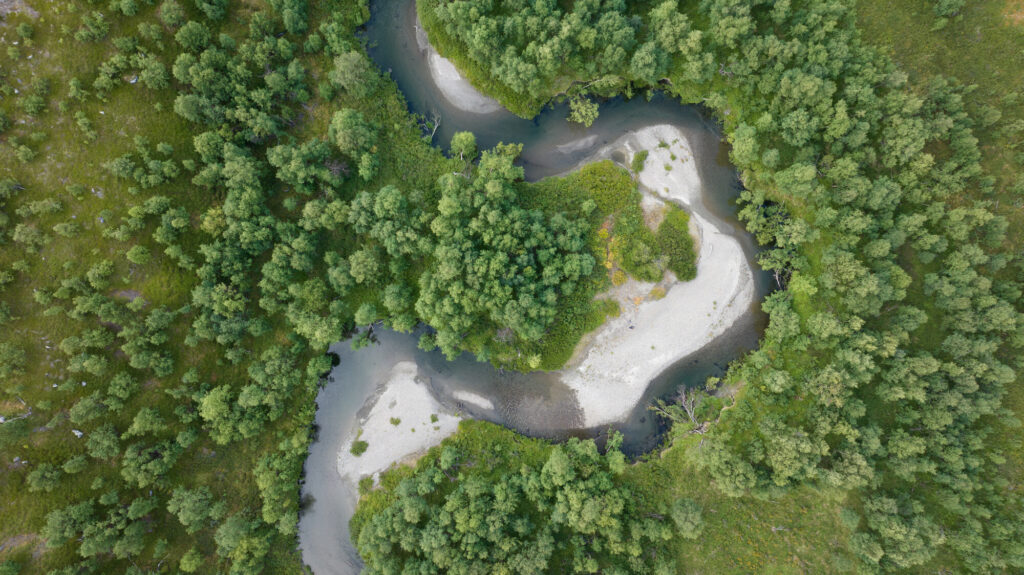A grant from the Open Rivers Programme has enabled the elimination of various small dams within the catchment of the Vindel River, within the Swedish Lapland rewilding panorama. By enabling the free circulation of water, it will assist to revitalise waterscapes and the wildlife populations they assist.
Reconnecting waterways
With monetary assist from the Open Rivers Programme, the Rewilding Sweden group have overseen the elimination of 4 small dams within the Swedish Lapland rewilding panorama. The boundaries have been all positioned inside the Vindelälven-Juhttátahkka Biosphere Reserve within the county of Västerbotten, to the northwest of town of Umeå.
The elimination of the 4 boundaries – known as the Strömbäcksdammen, Långträskdammen, Långhjuksnordammen, and Alträskdammen – will improve the connectivity of 84 kilometres of waterways. These waterways run into the free-flowing, 450-kilometre lengthy Vindel – the biggest tributary in Sweden – which itself flows into the Ume River. A second grant from the Open Rivers Programme will see 5 extra dams within the Vindel River catchment investigated for the potential for elimination by the Rewilding Sweden group subsequent 12 months.


Wholesome, free-flowing rivers
Synthetic boundaries are thought-about one of many most important threats to aquatic and riparian biodiversity on a world scale. They considerably degrade river ecosystems by inflicting habitat loss and fragmentation, altering the distribution of sediments and vitamins, and concentrating pollution.
Eradicating the dams within the Vindel River catchment will assist to re-establish pure river processes, enhancing general the general well being of the river system and revitalising aquatic habitats. In some circumstances, wooden floors that had been laid down on the mattress of the waterway was additionally eliminated.
“The dams and flooring have been bodily, engineered obstacles that have been stopping a spread of fish and different aquatic species from having the ability to transfer upstream and downstream,” explains Rewilding Sweden area officer Isak Edström. “So eradicating them will support migration. The restoration of pure circulation patterns and the transport of seeds and sediment can even improve the performance of the native ecosystem, benefitting a variety of animals and crops.”

Arthur de Bruin
Overcoming challenges
One of many most important challenges with the barrier elimination was to keep up the water stage upstream.
“When many of those dams have been constructed, boulders have been moved downstream to extend the distinction in top above and beneath them,” explains Isak Edström. “Eradicating the dams with out placing these stones again would have led to an unnatural drop in water ranges above the place the dams have been positioned. So it was vital to assemble pure tapered thresholds the place the dams have been. This additionally helps to enhance the pure aesthetics of the waterway and prevents the water circulation from turning into so nice that it hinders the motion of fish and different wildlife species.”

Arthur de Bruin

Arthur de Bruin
In the direction of wilder waterscapes
The elimination of riverine boundaries is a part of Rewilding Sweden’s long-term technique to rewild the catchment of the Vindel River by maximising the outcomes of earlier large-scale river restoration work within the space, and by connecting with additional rewilding efforts within the pipeline. By adopting a “waterscape” strategy, which goals to reinforce blue-green corridors for nature and wildlife by restoring the free circulation of water and enhancing the connection between rivers and surrounding landscapes, the group are aiming to create ecological synergies that amplify the advantages of their sensible rewilding efforts.
The Vindel River catchment is considered one of two areas the place the Rewilding Sweden group are engaged in long-term rewilding efforts. Along with eradicating dams, Rewilding Sweden can also be specializing in restoring drained wetlands and degraded forests right here. The restoration of forests will improve biodiversity and assist reindeer migration by a panorama dominated by industrial forestry.

Daniel Allen
A legacy of dams
Of the 4 boundaries which have or will likely be eliminated within the Vindel River catchment this 12 months, three are a legacy of Sweden’s lengthy historical past of industrial-scale forestry, which has had a big affect on the panorama.
From the 1850s, earlier than the age of street and rail, Sweden’s waterways have been engineered into unobstructed channels to create an enormous fluvial transport community. Rapids have been eliminated and bends straightened to permit logs to drift lots of of kilometres downstream for processing, whereas wooden floors was typically laid down on the beds of waterways to ease passage. An intensive community of drainage ditches, related to rivers, was dug to create drier soils for improved tree development. 1000’s of small dams have been additionally constructed, to artificially increase riverine water ranges within the spring. When logs have been prepared for transportation, these dams have been opened and the timber was carried downstream on the resultant circulation.
“There are a number of hundred of those out of date dams throughout the Vindel River catchment and the better Swedish panorama,” says Isak Edström. “Some have been eliminated already, however those who stay are all having a destructive ecological affect. In relation to enhancing the well being and performance of rivers and the areas related to them, eradicating these dams may be considered selecting the low-hanging fruit.”

Arthur de Bruin
Breaking boundaries on a European scale
Rivers ship a variety of important advantages to individuals and nature. With local weather change bringing new challenges, we urgently want a new relationship with water – accepting it into our landscapes once more, and rewilding it the place we will. This implies giving rivers the house and freedom to handle themselves, with dynamic, pure processes such because the free circulation of water and flooding returning them to well being. That is what Rewilding Europe is doing in lots of its personal landscapes, by measures reminiscent of dam elimination.
Dam elimination efforts within the Vindel River catchment align totally with European insurance policies on watercourse administration, which purpose to revive biodiversity and ecological connectivity. The efforts of the Rewilding Sweden group will contribute to attaining one of many elementary objectives of the European Biodiversity Technique, which goals to revive free-flowing situations on a minimum of 25,000 kilometres of European rivers by 2030.
Complementing the funding supplied by the Open Rivers Programme, monetary assist for the barrier elimination was additionally supplied by Rewilding Europe, which has been a part of the European motion for free-flowing rivers for a few years as a founding companion of Dam Removing Europe.


















